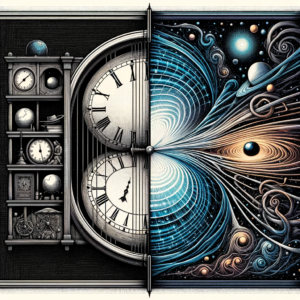Introduction
How many times in your life have you read a similar headline? Or have you pondered it yourself? So, what’s the deal with time? Does it exist or not? And can we travel through it? Even to the past? What is spacetime and what does the fourth dimension, in which we all live according to Einstein, look like? What’s inside a black hole? This text will attempt to answer (or does it answer?) some of the questions many contemporary and past scientists have explored. Perhaps the truth is much simpler than it seems. Or at least we can discuss it.

Thought Experiment – Fingers Outpace the Mind
For a long time, I was troubled by how things are arranged in the universe if (when) some aspects of Einstein’s theory of relativity are true. General relativity and its widely accepted views imply that mass curves spacetime, and the higher the mass, the more spacetime bends around it. This means that over a certain period, atomic clocks on the moon’s surface will show a different time than clocks on Earth’s surface. Imagine I could build miniature atomic clocks. I would create two of them. One would be implanted under the nail at the end of my hand, and the other would be placed in the center of my head. At the same time, I would be somewhere in space, far from other massive objects, planets, etc., that would influence this experiment. Another assumption is that the head is more massive than the finger, so its mass would cause greater gravity. According to general relativity, time on the clock in my finger would outpace the time measured by the clock in my head. And ultimately, two clocks placed anywhere in my body would sooner or later show different times. So, how is it arranged when time flows differently essentially in every part of my body? How is it possible that different particles of my body interact, even though they have different times? What ensures that I hold together within the “spacetime”? Shouldn’t I disintegrate into elementary particles based on all this? And if I wanted to return to the past by “one second”, what does that even mean? At the macro level, it’s basically clear to everyone what one second means, but at the level of those atomic clocks in my body, I would have to return each particle by a different “time” (and space).
What is Time?
From history, we have at least two views on what time is:
- Newton’s View of Time:
- Absolute Time: Newton considered time absolute, independent of the observer and environment. In his conception, time was constant and universal, flowing equally for all regardless of their motion or gravitational field.
- Immutable and Linear: Newton’s time is constant and unchanging, unaffected by any external influences.
- Einstein’s View of Time (in the framework of relativity):
- Relative Time: In Einstein’s theory of relativity, time becomes relative. This means that the measurement of time depends on the motion of the observer and the gravitational field. This phenomenon is known as time dilation.
- Space-Time Continuum: Einstein linked time with space, creating a four-dimensional space-time continuum. In this continuum, time and space influence each other.
- Gravity and Time: According to general relativity, gravity affects the flow of time. The stronger the gravitational field, the more time is slowed down.

Let’s now look at the whole problem from another perspective. Understanding this point of view is crucial for comprehending the following text. Let’s summarize some basic premises related to what we call time and how we as humans perceive it and related things:
- We all experience and perceive some “now” – a moment, or let’s say a snapshot, of the entire universe, or even all universes (or everything), which is given by that one moment called “now” (the present).
- It is likely that such “now” (from point 1.) occurred before (the past) and will occur afterward (the future).
- Time according to Newton is absolute, immutable, and linear.
- Time according to Einstein is relative, together with space forms the so-called spacetime, and is influenced by gravity.
Do you have a problem with any of these premises? Then try, at least for a moment, to accept that it could be true. Maybe just for the purposes of this text.
What can be deduced from these premises?
- We have something here that could be described as the flow of time according to points 1 and 2 (before, now, afterward) that has no unit and is something that cannot be measured by clocks. It is something that is more or less the subject of philosophical discussions. Does the past exist? Or is it just something in our memory? Perhaps the only thing that exists is now. We will not discuss this conception of time here and will leave it to the philosophers.
- Points 3. and 4. discuss the physical quantity called time, which has its basic unit (second). This unit was previously defined as a certain part of the day, later was refined several times, and now its size is defined as 9,192,631,770 oscillations of a cesium atom. In the future, we will certainly see further changes in the accuracy of measuring this unit. The important thing is that this time can be measured by clocks.
If we want to call what flows from point a. time, then we must realize that there are two times. First according to point a. and the second, according to point b.. They cannot be the same “thing” because the first cannot be measured while the second can be measured (by clocks).
To know which of these two times we will talk about further, we will introduce the term beyond-time for the time from point a. and we will continue to refer to time from point b. as time or also relative time.
Does (Relative) Time Exist?
Based on various observations and experiments, we know that Einstein’s definition of time is the “more correct” (than Newton’s), but on the other hand, several other questions have arisen, which Newton did not have to deal with. For example: is it possible to time travel, and can it be done to the past? But I will address this question a little later. Now let’s look at whether that (relative) time really exists.
Whether we talk about time according to Newton or Einstein, we always talk about units such as seconds, minutes, days, years, etc. But what is the definition of each of these units? Whether it’s our planet orbiting the sun (a year) or 9,192,631,770 oscillations of a cesium atom (a second), notice that the definition of a time unit is always movement. Physics tells us that movement occurs when the position of something changes over time. But if time is the definition of movement, then we find ourselves in a vicious circle. Just like the question of whether the egg or the chicken was first. Or is it not? And so, was movement or time first? Here, the situation and the answer are much simpler. Of course, movement was first. It had to be. Time is something invented by humans and “arose” only subsequently from movement, not vice versa.
Don’t believe it?
If a second is defined as a certain number of oscillations (changes) of a cesium atom, then it is precisely said in that definition. Movement (of an atom) defines a second, thus a unit of time, thus time itself. Show me any source of information where the unit of time is defined differently than by movement (of anything). There isn’t one! Time is always derived from movement.
Therefore, it follows that it is not time that determines movement, but the exact opposite. And at the same time, it means that time, as Einstein interprets it in his theory of relativity, does not exist! Nor does Newton’s. Both of their times, although they may seem different at first glance, are actually defined in exactly the same way. It is always and only movement.
Space-time -> Space-motion

If time is actually just movement, can we continue to talk about space-time? Shouldn’t we talk about space-motion? When we look at the definition of one second, it is defined as 9,192,631,770 oscillations of cesium atoms. If (and various experiments continue to prove this) Einstein was right with his theory of relativity, then what is relative from his theory is not time, but movement! This means that for different observers, the movement of different bodies (or particles) will flow differently. Thus, the number of particle oscillations they are composed of will be different. We can say that their aging – and that is precisely what is relative. What is relative, then, is the movement of particles through space. Really, we should not be talking about spacetime, but rather about space-motion “space-motion”. Or is it something else?
Space-motion -> Space
According to Einstein, gravity curves spacetime, leading to gravitational time dilation. However, gravity does not affect time, but movement – because, as we said, time = movement. If it is movement and not time, then only space can be deformed (curved), whose curvature affects movement in it. And since movement=time, then there is no dilation of time, but only curvature of space, based on which movement is affected. If the distance of space changes, it should also affect the number of oscillations that are carried out in this changed space. Should we, therefore, talk about space-motion? Given that movement occurs in space and movement itself does not expand or otherwise change this space, we should only talk about space “space”.
Black Hole

An interesting consequence of the above also applies to objects known as black holes. A black hole is just a part of space where length is very shortened, so much that the number of atom ticks for an observer is so small that it looks like it has stopped. And maybe it has stopped. However, there is no need to worry about time in such space, because it would just lead to the atom tick in atomic clocks (for the observer) taking a very long time, or never occurring. Nothing more, nothing less.
Time Travel

Thanks to the fact that time does not exist, it can be unequivocally said that we cannot travel through it. Not even back in time. Also, when we realize that “serious” consideration of time travel began only after the general acceptance of the theory of relativity, we can now calmly abandon it based on this text. In reality, only the process of aging (movement of particles) can be slowed down or accelerated relative to various observers. Time travel (to the past) is perhaps good for sci-fi literature, where details do not need to be fretted over. “Time travel” to the past is therefore unfeasible (and does not even make sense), and Stephen Hawking’s waiting for visitors to his time traveler party was in vain.
Conclusion
There are various definitions for units of time, and humans have gradually become dependent on them. We probably can’t imagine life without time (seconds, hours, days, etc.). Therefore, the purpose of this reflection is not to stop us as people from using something that has been long-term socially accepted and more or less works. The goal was to point out the overlooked fact that it is pointless to discuss things like time or even spacetime at the fundamental level of physics.
This also implies that we actually don’t know how to correctly define time. Such time that we, humans, can reliably work with. There is something we can call “now,” and it can be said that something will be afterward and something was also before. However, we cannot return there, no matter how.
The whole “groundbreaking” idea (which I have tried to capture here) is that I realized time is defined by movement, not vice versa, and that there are actually two kinds of time – one is Einstein’s/Newton’s – which this text deals with, and then another, let’s say intuitive (super-time), which comes from the fact that something was, something is, and something will also be. The Einsteinian time, used in the theory of relativity, which curves with space, such time does not exist.
For the purposes of physics, it would be necessary to define what this beyond-time is. Maybe based on quantum mechanics? And certainly, for the purposes of general physics, we will continue to use the time variable. Don’t worry, but the sun will rise again tomorrow.

The author of this text is Jaroslav Buček. This text was written based on his thoughts during the year 2023 and was published on December 14, 2023. Please note that I am deliberately mentioning only the date, not the time 😉
Quotations, copies, and translations of this text are possible only with the author’s consent.
Images were generated using the DALL·E tool and are for illustrative purposes only.